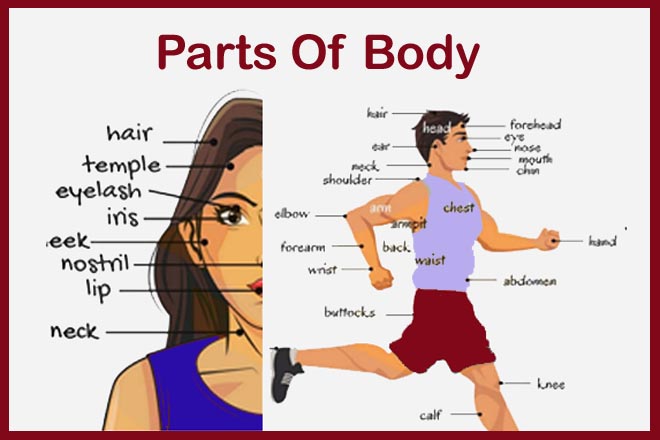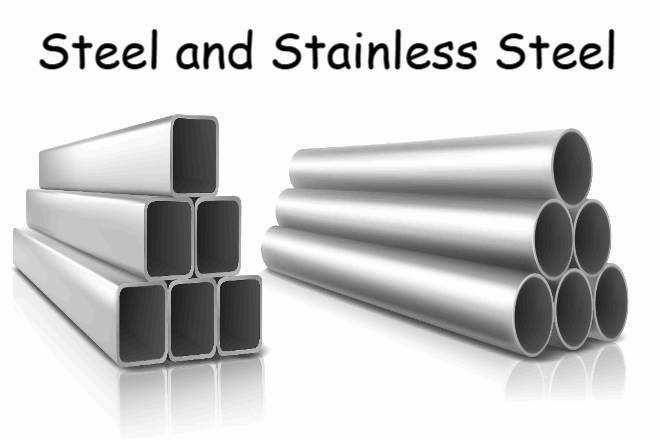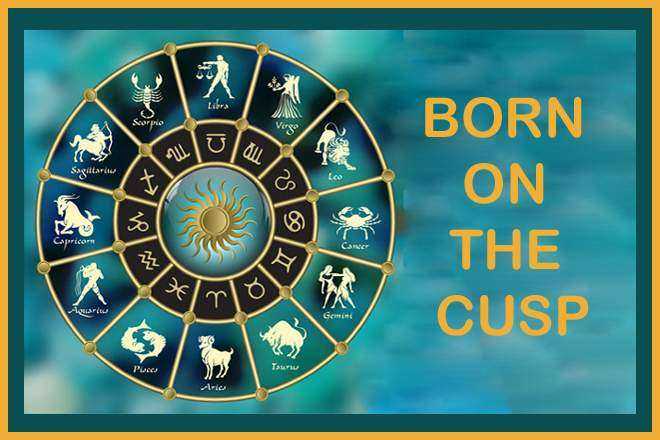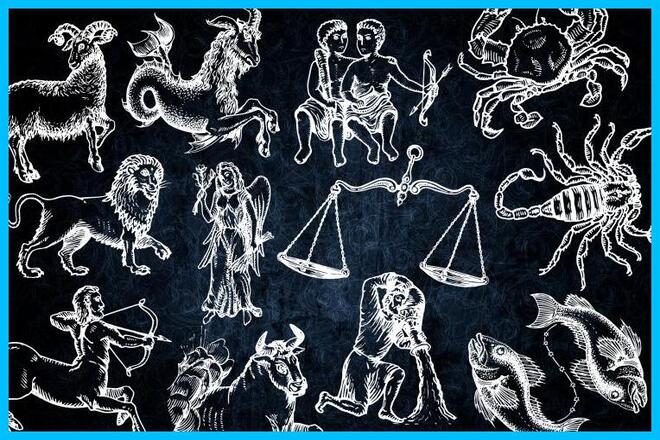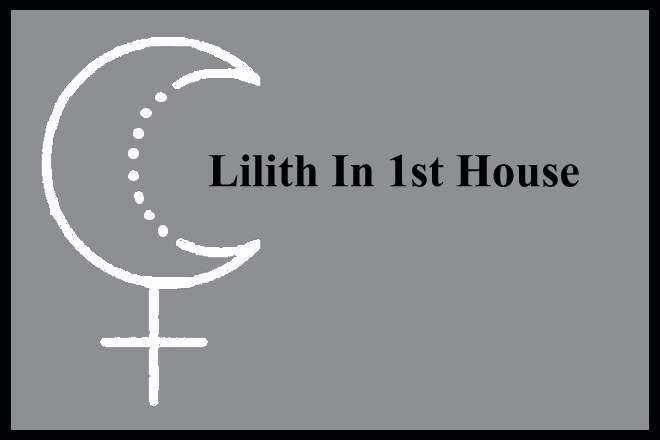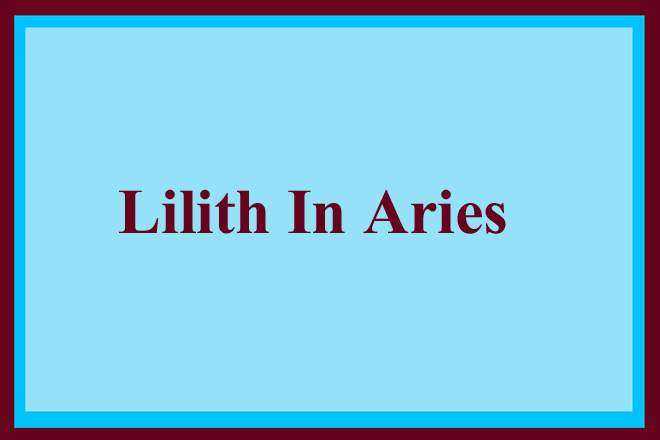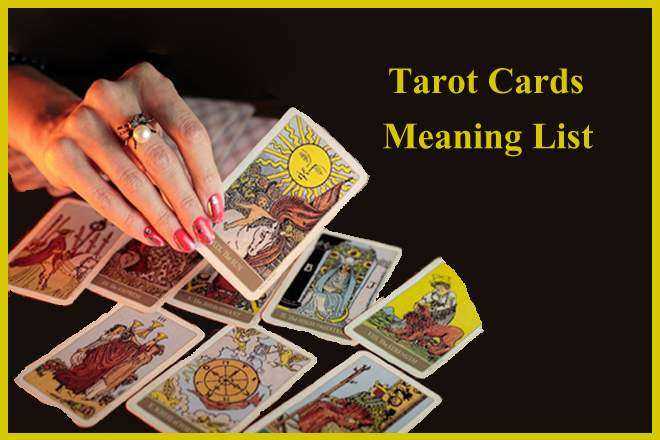Parts Of Body Name In English, Body Parts By Name, Human Body Parts Pictures With Names, What Is The All Body Parts Name?
Parts Of Body – Introduction
The human body, a complex and intricate marvel of evolution, consists of numerous systems and parts working in harmony to sustain life. Comprising trillions of cells, the body is a symphony of processes occurring simultaneously. Here’s a brief overview of its main parts:
Parts Of Body / Human Body Parts Name
- Head
- Forehead
- Hair
- Face
- Skin
- Eye
- Eyelash
- Eyebrow
- Ear
- Nose
- Mouth
- Lips
- Teeth
- Tongue
- Mustache
- Beard
- Cheeks
- Chin
- Neck
- Shoulder
- Chest
- Breast
- Nipple
- Abdomen
- Navel
- Armpit
- Arm
- Elbow
- Forearm
- Wrist
- Hand
- Palm
- Thumb
- fingers
- Nail
- fist
- Waist
- Back
- Hip
- Buttocks
- Penis
- Vagina
- Thigh
- Leg
- Knee
- Calf
- Heel
- Foot
- Toes
- Toenail
- Sole
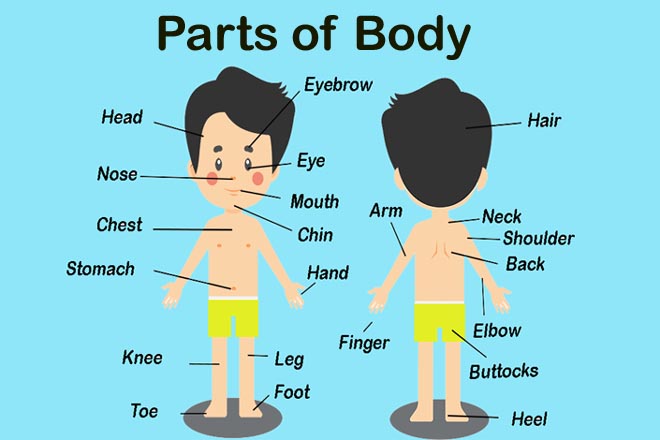
Five Sense Organs | What are the Sense Organs?
The five sense organs in humans, corresponding to the traditional five senses, are essential structures that allow us to perceive and interact with our environment. Here’s a brief overview:
Eyes (Vision)
Function: The eyes are responsible for sight, allowing us to perceive color, depth, movement, and details of our surroundings. The retina, located inside the eye, contains light-sensitive cells that capture and process light.
Ears (Hearing)
Function: The ears capture sound waves and convert them into signals that our brain can interpret. The outer ear collects sound waves, which then travel through the middle ear and are further processed in the inner ear by the cochlea.
Tongue (Taste)
Function: The tongue has thousands of taste buds that can detect different basic tastes: sweet, salty, bitter, sour, and umami. These taste buds send signals to the brain about the taste of foods and drinks we consume.
Nose (Smell)
Function: The nose contains olfactory receptors that are sensitive to various chemicals in the air. When we breathe in, these receptors pick up different smells and send signals to the brain, which then identifies and interprets these odors.
Skin (Touch)
Function: The skin, the body’s largest organ, is sensitive to touch, temperature, pain, and pressure. It contains various types of receptors that send signals to the brain when stimulated, allowing us to feel sensations like warmth, cold, softness, roughness, and more.
These five sense organs provide crucial information to the brain, allowing us to understand and respond to our environment. They work in tandem and often overlap, enriching our sensory experience and perception of the world.
Parts Of The Head
Certainly! The head houses several important structures related to sensory input, cognition, and basic life functions. Here are the main parts of the head and a brief description of each:
- Skull: The bony structure that provides protection for the brain and supports the face. It’s made up of multiple bones fused.
- Forehead: The front part of the head above the eyebrows.
- Face: The front part of the head from the chin to the forehead.
- Eyes: Organs responsible for vision, set in the eye sockets (orbits) of the skull.
- Eyebrows: Arches of hair above the eyes that aid in non-verbal communication and prevent sweat from reaching the eyes.
- Eyelids: Protective flaps that cover the eyes, helping to keep them moist and free of debris.
- Eyelashes: Short hairs on the edge of the eyelids, which protect the eyes from small particles and dust.
- Ears: Organs responsible for hearing and balance, located on either side of the head.
- Nose: Protruding structure that houses the nostrils and is involved in breathing and the sense of smell.
- Mouth: Opening used for eating, breathing, and speaking. It includes the lips, teeth, gums, tongue, and the roof and floor of the mouth.
- Cheeks: Fleshy areas on either side of the face, below the eyes and between the nose and ears.
- Chin: The protruding part at the base of the face, below the mouth.
- Jaw: The framework that supports the lower face and includes the mandible (lower jaw) and maxilla (upper jaw).
- Temples: The flat regions on the sides of the forehead, behind the eyes.
- Scalp: The skin-covered surface on the top of the head, which usually has hair.
- Hair: Filamentous strands growing from follicles found in the dermis of the scalp and other parts of the body.
- Brain: The primary organ of the central nervous system, housed within the skull, responsible for cognition, sensory processing, and many vital functions.
- Neck: Though not strictly a part of the head, the neck supports the head and connects it to the torso. It contains many structures, including the cervical spine, trachea, esophagus, and major blood vessels.
These are the primary parts and structures of the head. Each plays a specific role in sensory perception, communication, protection, or other essential functions.
Parts Of The Eye
Of course! The eye is a complex organ responsible for the sense of vision. Here are the main parts of the eye and a brief description of each:
- Sclera: The white outer covering of the eye. It provides protection and helps maintain the shape of the eye.
- Cornea: The clear, front surface of the eye. It refracts (bends) light entering the eye, aiding in the focus of images.
- Iris: The colored part of the eye. It controls the amount of light that enters the eye by adjusting the size of the pupil.
- Pupil: The black, central opening in the iris. It expands or contracts to control the amount of light entering the eye.
- Lens: A clear, flexible structure situated behind the iris. It further refracts light to focus it onto the retina.
- Retina: The innermost layer of the eye, located at the back. It contains photoreceptor cells (rods and cones) that detect light and send signals to the brain through the optic nerve.
- Macula: A small central area in the retina. It contains the highest concentration of cones and is responsible for central vision and the detection of fine details.
- Optic Nerve: A bundle of nerve fibers that transmits visual information from the retina to the brain.
- Choroid: A layer between the retina and the sclera. It contains blood vessels that provide oxygen and nutrients to the retina.
- Eyelid: Protects the eye from foreign bodies, dust, and excessive light. It also helps spread tears across the eye’s surface.
- Eyelashes: Small hairs on the edge of the eyelids that help protect the eye from debris.
- Tear Ducts: Channels that carry tears from the eye’s surface to the nose.
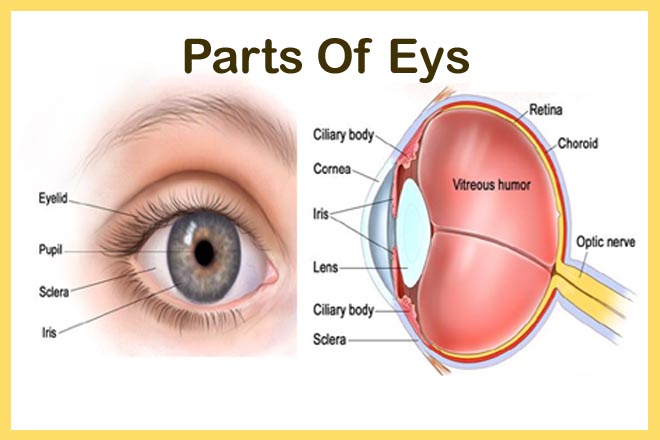
Parts Of The Ear
Certainly! The ear is a complex organ responsible for both hearing and balance. It can be divided into three main parts, each with its specific structures:
1. Outer Ear (External Ear):
. Pinna (or Auricle): The visible part of the ear that protrudes from the head. It’s designed to capture sound waves and direct them into the ear canal.
. External Auditory Canal (or Ear Canal): A tubular passage leading inward from the opening of the external ear to the eardrum. It conducts sound waves from the auricle to the eardrum.
. Ceruminous Glands: Glands located in the ear canal that produce cerumen (earwax), which helps protect and lubricate the ear.
2. Middle Ear:
. Tympanic Membrane (or Eardrum): A thin, cone-shaped membrane that separates the external ear from the middle ear. It vibrates in response to sound waves, initiating the mechanical process of hearing.
. Ossicles: Three tiny bones that amplify and transmit the vibrations from the eardrum to the inner ear. They are:
. Malleus (or Hammer): Connected to the eardrum.
. Incus (or Anvil): Lies between the malleus and stapes.
. Stapes (or Stirrup): Connected to the oval window of the cochlea in the inner ear.
. Eustachian Tube (or Auditory Tube): A tube that connects the middle ear to the nasopharynx (back of the nose and upper throat). It helps equalize pressure in the middle ear.
3. Inner Ear (or Labyrinth):
. Cochlea: A spiral-shaped, fluid-filled structure responsible for hearing. It contains the organ of Corti, where sound vibrations are transformed into electrical signals.
. Vestibule: The central part of the inner ear, which is involved in balance. It contains two sac-like structures:
Utricle
Saccule
. Semicircular Canals: Three looped tubes arranged roughly at right angles to one another. They detect rotational movement and help maintain balance.
The auditory nerve (or cochlear nerve) then carries these electrical signals from the cochlea to the brain, where they are interpreted as sound.
This overview highlights the main parts of the ear. Each part plays a crucial role in the process of hearing and maintaining balance.
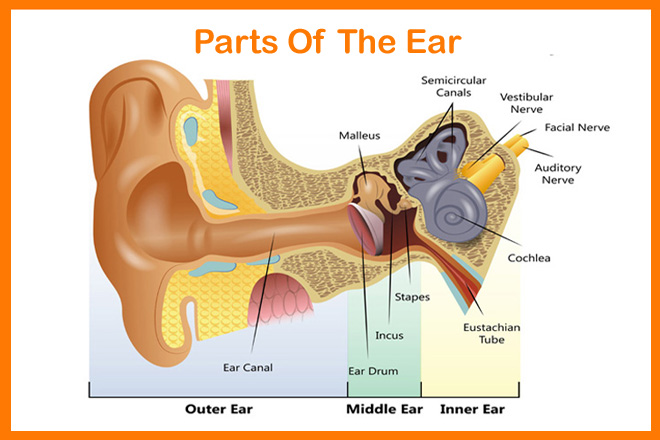
Parts Of The Nose
Certainly! The nose is a prominent feature of the face and is involved in breathing and the sense of smell. Here are the main parts of the nose and a brief description of each:
- Nostrils (Nares): The two external openings of the nose. They allow the passage of air in and out during breathing.
- Nasal Bridge: The upper, bony part of the nose, which connects the nose to the forehead.
- Nasal Tip: The front, lower part of the nose. It’s the protruding end of the nose and is primarily cartilaginous.
- Nasal Septum: The partition that divides the nose into two nasal cavities. It’s composed of both bone (at the back and base) and cartilage (in the front).
- Nasal Cavity: The hollow space inside the nose, which starts at the nostrils and leads to the back of the throat. It’s lined with mucus membranes and has a vital role in warming, humidifying, and filtering the air we breathe.
- Turbinates (Nasal Conchae): Curved bones and associated soft tissues that protrude into the nasal cavity. They increase the surface area of the nose, enhancing its functions of warming, humidifying, and filtering air.
- Nasal Vestibule: The part of the nasal cavity just inside the nostrils. It’s where nose hairs (vibrissae) are located, which help filter large particles from inhaled air.
- Ala (Plural: Alae): The rounded, fleshy external part on the sides of the nostrils.
- Columella: The flesh that separates the two nostrils at the base of the nose, running from the nasal tip to the upper lip.
- Paranasal Sinuses: Air-filled cavities located in the bones surrounding the nasal cavity. They help reduce the weight of the skull, influence the tone of our voice, and produce mucus. The main sinuses are:
. Maxillary Sinuses: Located in the cheekbones.
. Frontal Sinuses: Located in the forehead.
. Ethmoid Sinuses: Located between the eyes.
. Sphenoid Sinuses: Located deep behind the nose. - Olfactory Epithelium: A specialized tissue located at the roof of the nasal cavity responsible for the sense of smell. It contains olfactory receptors that detect odor molecules.
- Nasolacrimal Duct: A channel that connects the eye to the nasal cavity, allowing for the drainage of tears.
These are the primary structures and parts of the nose. Each part plays a specific role in breathing, filtration, olfaction (sense of smell), or other functions.
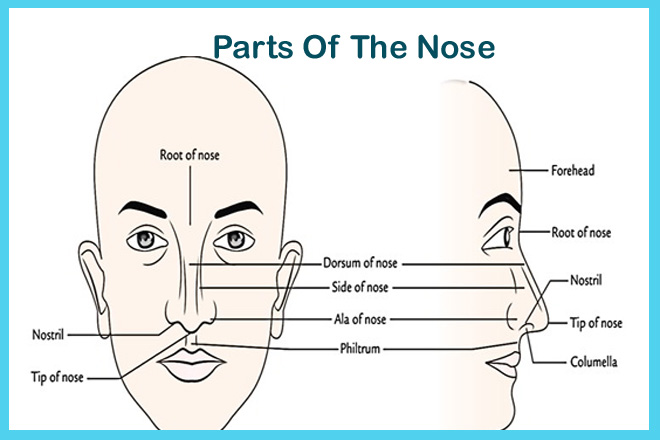
Parts Of The Mouth
Certainly! The mouth (or oral cavity) is a complex structure involved in various functions, including speech, breathing, and the initial stages of digestion. Here are the main parts of the mouth and a brief description of each:
- Lips: The soft, movable outer structures that surround the opening of the mouth. They help with articulation in speech, facial expressions, and sealing the oral cavity.
- Teeth: Hard, calcified structures used for biting, chewing, and grinding food. Adults typically have 32 teeth, including incisors, canines, premolars, and molars.
- Gums (Gingiva): Soft tissue that surrounds and supports the teeth. It provides a seal around each tooth, protecting the underlying bone and tooth roots.
- Tongue: A muscular organ that aids in chewing, swallowing, taste sensation, and speech. It has various regions:
. Tip (Apex): The front part of the tongue.
. Body: The main part of the tongue.
. Dorsum: The top surface of the tongue.
. Base: The back part of the tongue, near the throat. - Palate: The roof of the mouth, divided into 2 Part Hard Palate and Soft Palate:
. Hard Palate: The front bony part.
. Soft Palate: The soft, flexible rear part that extends to the uvula. - Uvula: The small, cone-shaped tissue that hangs from the soft palate at the back of the mouth.
- Salivary Glands: Glands that produce saliva, which moistens food, aids in digestion, and helps cleanse the mouth. The main salivary glands are:
- Parotid Glands: Located in front of the ears.
- Submandibular Glands: Situated below the jaw.
- Sublingual Glands: Located under the tongue.
- Tonsils: Lymphoid tissues located at the back of the mouth, on either side of the base of the tongue. They play a role in the immune response to pathogens.
- Vestibule: The space between the teeth, lips, and cheeks.
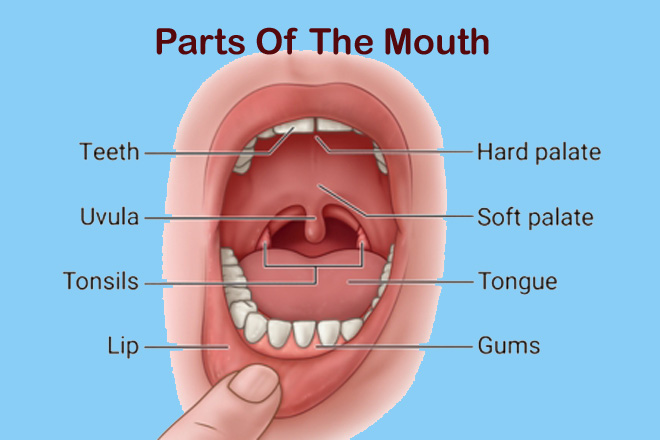
Parts Of The Hand
Certainly! The hand is a highly specialized and intricate structure involved in a wide variety of functions, from fine motor skills to sensory perception. Here are the main parts of the hand and a brief description of each:
- Palm (Palmar Surface): The inner surface of the hand that faces towards the body when in a natural position.
- Back of the Hand (Dorsal Surface): The outer surface of the hand that faces away from the body.
- Fingers: There are five fingers on each hand, each comprising multiple phalanges (segments). From the thumb to the little finger:
. Thumb (Pollex): The first and shortest finger, which has two phalanges.
. Index Finger: The second finger, used for pointing.
. Middle Finger: The longest finger.
. Ring Finger: The fourth finger.
. Little Finger (Pinky or Digitus Minimus): The fifth and smallest finger. - Phalanges: The bones that make up the fingers. Each finger has three phalanges (proximal, middle, and distal) except for the thumb, which has two (proximal and distal).
- Metacarpals: The five long bones located in the palm, connecting the wrist to the fingers.
- Carpals: The eight small bones arranged in two rows that form the wrist. They connect the hand to the forearm.
- Wrist (Carpal Tunnel): The junction between the forearm and the hand. The carpal tunnel is a narrow passageway surrounded by bones and ligaments, through which the median nerve and tendons pass.
- Knuckles: The joints where the phalanges and metacarpals meet, which are prominent when the hand is clenched.
- Nails: Hard, protective plates covering the dorsal aspect of the tips of fingers and thumbs.
- Webbing: The skin between the bases of each finger.
- Thenar Eminence: The fleshy portion of the palm at the base of the thumb.
- Hypothenar Eminence: The fleshy portion of the palm at the base of the little finger.
- Flexor Creases (or Flexion Folds): The lines on the palm. The most notable are the heart line, head line, and life line.
- Tendons: Bands of tissue that connect muscles to bones, allowing for movement. In the hand, they are especially prominent and facilitate finger and thumb movements.
These are the primary structures and parts of the hand. Each part contributes to the hand’s myriad functions, from grasping objects to tactile sensory perception.
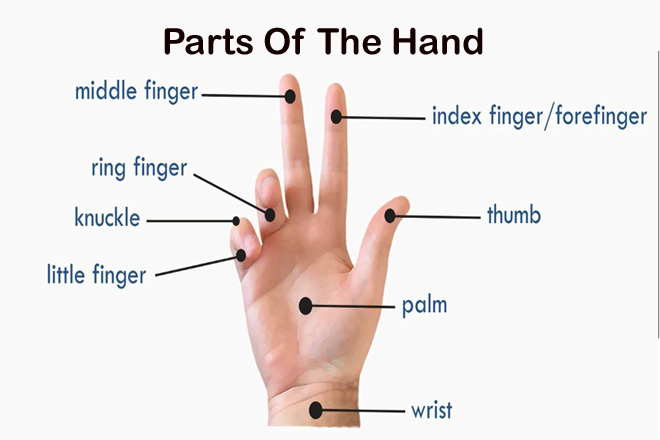
Parts Of The Leg
Certainly! The leg is a major weight-bearing and locomotive structure of the body, facilitating movement and balance. Here are the main parts of the leg and a brief description of each:
- Thigh: The upper portion of the leg between the hip and the knee.
- Knee: A major hinge joint that connects the thigh to the lower leg. It is the largest joint in the body.
- Calf: The back portion of the lower leg, situated between the knee and the ankle.
- Shin (or Tibia): The front portion of the lower leg, situated between the knee and the ankle.
- Ankle: The joint connecting the lower leg to the foot.
- Femur (Thigh Bone): The longest and strongest bone in the human body, located in the thigh.
- Patella (Knee Cap): A small, flat, triangular bone located at the front of the knee joint. It protects and maintains the joint’s stability.
- Tibia: The larger, inner bone of the lower leg, commonly known as the shinbone.
Fibula: The smaller, outer bone of the lower leg. - Achilles Tendon: A strong, fibrous tissue that connects the calf muscles to the heel bone (calcaneus). It aids in walking, running, and jumping.
- Hamstrings: A group of muscles and their tendons located at the back of the thigh. They help in bending the knee and extending the hip joint.
- Quadriceps: A group of muscles located at the front of the thigh. They are responsible for extending or straightening the knee.
- Gastrocnemius and Soleus: Muscles of the calf responsible for plantar flexion of the foot (pointing the toes).
- Crural Fascia: The connective tissue surrounding the muscles of the lower leg.
- Popliteal Fossa: The shallow depression located at the back of the knee joint. It contains tendons, blood vessels, and nerves.
- Tarsal Bones: A group of seven bones in the foot, close to the ankle.
- Talocrural Joint: The main ankle joint formed by the bones tibia, fibula, and talus.
These are the primary structures and parts of the leg. Each component plays a specific role in facilitating movement, providing support, and maintaining balance.
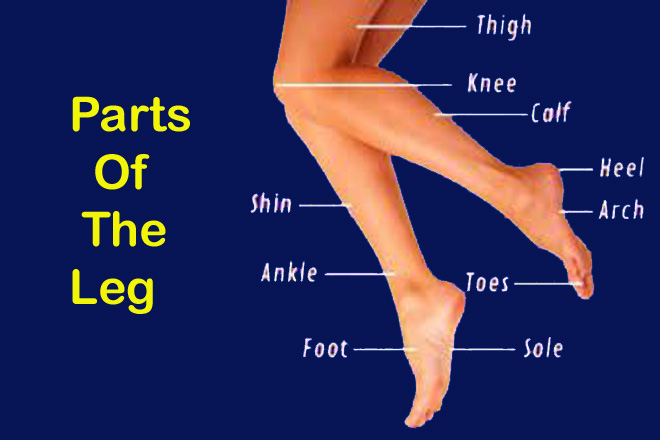
Internal Body Parts
Brain
Heart
Lungs
Liver
Stomach
Kidneys
Bladder
Pancreas
Spleen
Gallbladder
Small Intestine
Large Intestine (Colon)
Appendix
Prostate (in males)
Ovaries (in females, 2)
Uterus (in females)
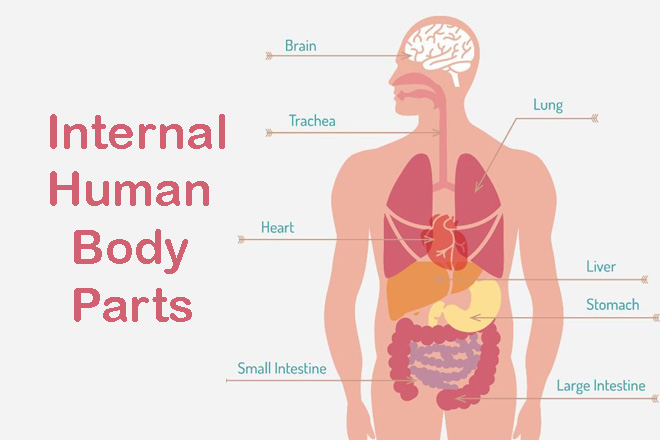
Internal Body Parts : Functions
Certainly! The human body houses numerous vital internal organs that play crucial roles in sustaining life and maintaining our overall health. Here’s a list of major internal organs and a brief description of each:
- Brain: Located in the skull, it controls and coordinates most sensory systems, movement, behavior, and homeostatic body functions such as heartbeat, blood pressure, fluid balance, and body temperature.
- Heart: A muscular organ located in the chest, it pumps blood throughout the body via the circulatory system.
- Lungs: Pair of respiratory organs situated in the chest. They oxygenate blood and remove carbon dioxide through the process of breathing.
- Liver: A large organ located in the upper right abdomen. It detoxifies chemicals, metabolizes drugs, produces bile, and processes nutrients.
- Stomach: A muscular organ located in the abdomen. It receives food from the esophagus and begins the digestion process.
- Kidneys: Bean-shaped organs located on either side of the spine, below the ribcage. They filter waste products from the blood to produce urine.
- Bladder: A muscular sac located in the pelvis. It stores urine produced by the kidneys until it is eliminated from the body.
- Pancreas: Located behind the stomach. It produces enzymes that help digest food and secretes insulin, which regulates blood sugar.
- Spleen: Located under the ribcage on the left side. It filters blood, recycles old red blood cells, and stores platelets and white blood cells.
- Gallbladder: A small pouch situated beneath the liver. It stores bile produced by the liver.
- Small Intestine: Long, coiled tube in the abdomen that receives partially digested food from the stomach. It’s responsible for further digestion and nutrient absorption.
- Large Intestine (Colon): A tube connected to the small intestine. It absorbs water and forms feces.
- Appendix: A small, tube-shaped pouch attached to the large intestine. Its exact function is not clearly understood, but it is thought to be involved in immune function.
- Prostate (in males): A gland located beneath the bladder in males. It produces fluid that nourishes and protects sperm.
- Ovaries (in females, 2): Located on both sides of the uterus in females. They produce eggs (ova) and female hormones.
- Uterus (in females): A muscular organ located in the female pelvis. It houses a developing fetus during pregnancy.
These internal organs are vital to various physiological processes and functions in the body. Each has its unique role, and disruptions or diseases affecting these organs can have significant implications for overall health.
Questions/Answers related to human body
Question 1: How many bones are in the human body?
Answer: The human body is born with approximately 270 bones. However, as a person grows, some of these bones gradually fuse together. By the time an individual reaches adulthood, the number of bones typically totals 206.
Question 2: How many Litres of blood is in the human body?
Answer: An average adult has between 5 to 6 liters of blood in their body. The exact amount can vary based on factors such as age, sex, weight, and overall health.
Question 3: How many times does the heart beat in a minute?
Answer: In a normal adult person the heart beats about 60 to 100 times in a minute.
Question 4: What is the largest organ in the human body?
Answer: Skin is the largest organ of the human body.
Question 5: Which is the heaviest organ in the human body?
Answer: The heaviest organ in the human body is the liver.
Question 6: Which organ is responsible for pumping blood throughout the body?
Answer: The organ responsible for pumping blood throughout the body is the heart.
Question 7: Which part of the body is responsible for the sense of smell?
Answer: The nose.
Question 8: Which is the smallest bone in the human body?
Answer: The smallest bone in our body is of the ear and is called stapes. It is 0.25 cm in size. Let us tell you, this bone is smaller than a grain of rice.
Question 9: Which organ in the human body produces insulin?
Answer: The organ in the human body that produces insulin is the pancreas.
Question 10: How many types of muscles are there in the human body?
Answer: There are three types of muscles in the human body: skeletal, smooth, and cardiac.
Question 11: Which is the longest bone in the human body?
Answer: The longest bone in the human body is the thigh, whose size is 46 centimeters.
Question12 : Which part of the human eye is helpful in seeing color?
Answer: A part called ‘cones’ located in the retina is helpful in seeing colors.
Question 13 : How many mega pixels are the eyes of a human being?
Answer: A human eye has 576 mega pixels.
Question 14 : Which part of the human eye allows us to focus on different objects?
Answer: The lens.
Question 15 : What is the primary function of the lungs?
Answer: To exchange oxygen and carbon dioxide with the blood.
Question 16 : Which part of the brain is responsible for regulating vital functions like heartbeat and breathing?
Answer: The medulla oblongata.
Question 17 : What are the joints called where your fingers bend?
Answer: The joints where your fingers bend are called knuckles.
Parts Of Body Name In English, Body Parts By Name, Human Body Parts Pictures With Names, What Is The All Body Parts Name?




